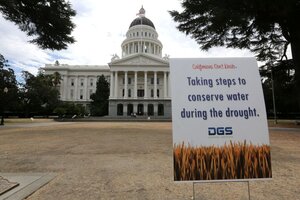Gov. Brown extends California's water limits: 'We are in a new era.'
As Californians enter their fifth year of drought, many are changing their daily habits as they realize that temporary inconveniences, and the drought itself, may be here to stay.

In this June 2014 file photo, landscapers at the California state Capitol in Sacramento have removed the lawn in hopes of inspiring citizens to do the same, as the state continues water conservation efforts in the face of extreme drought. (June 2014)
Rich Pedroncelli/ AP/ File
Governor Jerry Brown prepared Californians to enter their fifth year of a seemingly interminable drought on Friday by extending an executive order that mandated a 25-percent reduction in water usage across the state.
The original order, issued in April, could now be extended until October 2016 if the drought persists through January.
Although El Niño is expected to shower California with much-needed rainfall, and Governor Brown fast-tracked initiatives to capture as much as possible, meteorologists predict it won't be enough to solve the state's water woes, which have begun to reshape Californians' habits, from landscaping to cooking.
"People should realize we are in a new era," Brown said at a news conference last spring, announcing the state's first-ever mandated water limits. "The idea of your nice little green lawn getting watered every day, those days are past."
A previous effort to encourage Californians to voluntarily reduce their water usage by 20 percent, beginning in January 2014, fell short of the target.
The executive order's goal is to reduce local water suppliers' usage by 25 percent, but each community has its own specific limit, determined after taking other factors into account, such as whether residents have already begun taking fewer showers or ceased watering unnaturally lush lawns.
In a state where nature-defying landscape is more of a status symbol than a practicality, many homeowners, particularly in wealthy enclaves, have flouted the limits and handed over fines, or at least grumbled about what they consider unfair changes.
"You could put 20 houses on my property, and they'd have families of at least four. In my house, there is only two of us," interior designer Gay Butler said of her large estate. So "they'd be using a hell of a lot more water than we're using."
"What are we supposed to do, just have dirt around our house on four acres?" she asked The Washington Post's Rob Kuznia.
More or less. One of the state's most successful water-reduction efforts has been rebates to encourage homeowners to tear out their grass lawns, in favor of artificial turf or desert-friendly native plants.
In July, the Metropolitan Water District of Southern California was forced to stop the program after spending $450 million; overwhelmed by applicants, it simply ran out of money, after saving the equivalent of 160,000 households' worth in water.
With or without lawns, Californians have turned #droughtshaming into a new competitive hobby, using social media to pinpoint neighborhood suspects: who's washing their car too often? Whose flowers look suspiciously healthy?
According to The New York Times, drought has changed culinary habits, too, particularly in restaurant kitchens, where steaming, not boiling, is growing in popularity, and chefs must wrestle with new inconveniences, such as the altered taste of dairy products, now that animals' diets have shifted away from grass.
The question is whether citizens will treat the changes as a temporary challenge, or a long-term shift, which may take years to tell. Then again, the drought itself may be here to stay, at least for several more years.
"The rebate program was intended to stimulate interest in turf removal to the point that government incentives were not necessary for the long term," the Metropolitan Water District's general manager, Jeffrey Kightlinger, explained when announcing its closure.
Even if adaptations catch on with everyday citizens, the state's next challenge may be tackling large-scale water use in the agriculture and tourism industries.
"The economy is built on never-ending growth," Coachella Valley Sierra Club leader Jeff Morgan told reporter Lisa M. Krieger last month. "But you can’t grow water."

